
What to Wear in Japan: Complete Seasonal Packing Guide & Tips to Lighten Your Luggage
- Written by: LIVE JAPAN Editor
Wondering what to wear in Japan during your trip and what clothing is appropriate? The weather makes a huge difference in the kinds of clothes and accessories you'll want to pack! Plus, you'll want to know whether it's okay to wear certain kinds of outfits.
From spring to winter, here are the recommended items for what to wear in Japan.
- Table of Contents
-
- What to Wear in Japan in Spring (March/April/May)
- What to Wear in Japan in Summer (June/July/August)
- What to Wear in Japan in Autumn (September/October/November)
- What to Wear in Japan in Winter (December/January/February)
- Check Out ‘Any Wear, Anywhere’ – Smart Packing Made Easy
- Helpful Articles for Planning Your Japan trip
What to Wear in Japan in Spring (March/April/May)

Spring in Japan is a time of renewal—and one of the most beautiful times to visit. As cherry blossoms begin to bloom from late March through April in much of the country, people gather for hanami (flower-viewing) picnics and scenic strolls. Days gradually warm up, but mornings and evenings can still be chilly, especially in March and early April.
Layering is key—pack a light jacket, a sweater, and clothes you can easily add or remove. Tokyo sees its biggest seasonal temperature swing from March to May, with averages rising from 10°C (50°F) to nearly 20°C (68°F). This is also a great time for day trips around Tokyo, Osaka, and Kyoto, thanks to the mild weather and longer daylight hours.
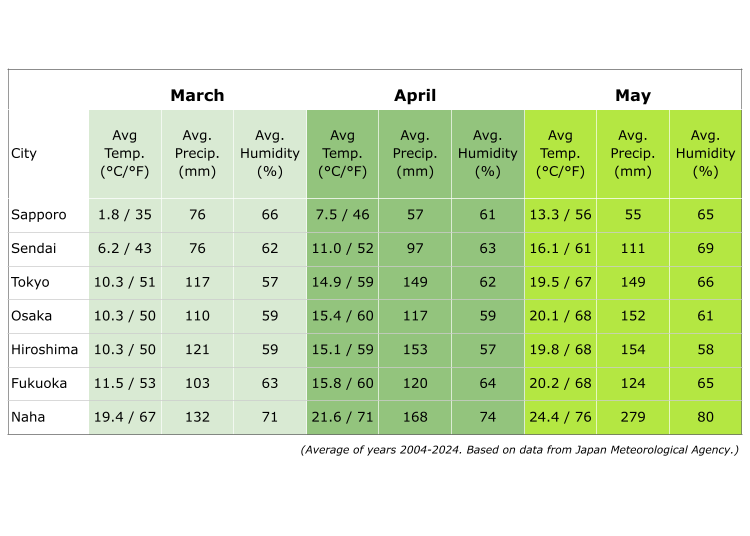
March

March marks the start of spring in Japan, but the weather can still feel wintry in the mornings. Expect daytime highs near 13°C (56°F), but chilly spells below 10°C (50°F) are common. This is a transitional month—while plum blossoms begin to bloom in Tokyo, the snowy landscape lingers in Sapporo. Layering is key, and travelers will appreciate how coats can come off midday and go back on at night. Sunset in Tokyo ranges from 5:35 PM to 6:00 PM, creating lovely evening light for strolls in parks or neighborhoods like Yanaka.
- Outerwear
- Medium to heavy coat or insulated jacket (light down or wool recommended)
- Tops
- Thermal undershirt; sweater or warm knit top; long-sleeved base layers
- Bottoms
- Thick pants or jeans; optional knit skirt with warm tights
- Thick pants or jeans; optional knit skirt with warm tights
- Comfortable shoes or boots (preferably water-resistant); knit cap; muffler or scarf; face mask (for wind, allergies, or pollen); disposable heating pads
April

April is cherry blossom season in much of Japan. Cities like Tokyo and Osaka are filled with hanami (flower-viewing) picnics, while northern regions like Tohoku and Sapporo bloom later. Afternoons are mild, but it’s wise to bring layers for cooler mornings. April can be rainy, so pack a light raincoat or umbrella. Sunset in Tokyo stretches from 6:00 PM to 6:25 PM—ideal for catching golden-hour views of cherry blossoms along rivers or in historic gardens. First-time visitors should also note that many locals take time off in late April during Golden Week, a cluster of national holidays.
- Outerwear
- Windbreaker or light jacket (thicker coat for Sapporo)
- Tops
- Long-sleeved shirts; thin sweater or light knit; cut-and-sew tops
- Bottoms
- Pants or jeans; skirt with tights (optional)
- Footwear & Accessories
- Light shoes with waterproof soles; compact umbrella or raincoat; mask (for pollen); optional scarf for cooler mornings
May

May is one of the best times to visit Japan. The weather is warm and comfortable, humidity is low, and the skies are often clear. In Tokyo, Osaka, and Fukuoka, the first half of the month feels like early summer. In contrast, northern Japan—including Tohoku and Hokkaido—is just hitting peak cherry blossom season, so the beginning of May is an excellent time to head north. Sunset in Tokyo gradually shifts from 6:25 PM to 6:50 PM, giving you long, bright days. Lightweight clothing and sun protection are highly recommended. Public transport may be crowded during Golden Week (first week of May), so plan accordingly.
- Outerwear
- Thin coat, hooded jacket, or light cardigan (especially for Sapporo or early mornings in Tohoku)
- Tops
- T-shirts; lightweight blouses or shirts; long sleeves for sun or breeze and to layer in evenings
- Bottoms
- Pants, jeans, or skirt; optional light stockings or leggings
- Footwear & Accessories
- Comfortable walking shoes or sneakers; umbrella or light rain jacket; sun protection like a hat or sunglasses (especially in southern regions)
Mind the rainy season in Japan (June-July)!

In the Kanto area (greater Tokyo), the rainy season generally lasts from early June to the end of July. This time brings both hot and cold days, as well as a good deal of unstable weather.
A lot of people experience headaches and other ailments due to sudden drops in atmospheric pressure, so if you’re affected by such changes, it’s a good idea to carry medicine with you just in case.
- Rainy season start date
- ・2024 – Tokyo: Around June 21; Osaka: Around June 17
・30-year average – Tokyo: Around June 7; Osaka: Around June 5
- Rainy season end date
- ・2024 – Tokyo: Around July 19; Osaka: Around July 18
・30-year average – Tokyo: Around July 19; Osaka: Around July 17
What to Wear in Japan in Summer (June/July/August)

Summer in Japan begins with the rainy season (tsuyu) in June, followed by hot, humid weather from July onward. Temperatures often exceed 30°C (86°F) in many parts of the country, and the humidity can be intense—especially in cities like Tokyo and Osaka. Light, breathable clothing is essential, along with sun protection like a hat, sunscreen, and a hand towel or portable fan.
If you’ll be outdoors for long periods, stay hydrated and take breaks in shaded or air-conditioned areas to avoid heatstroke.
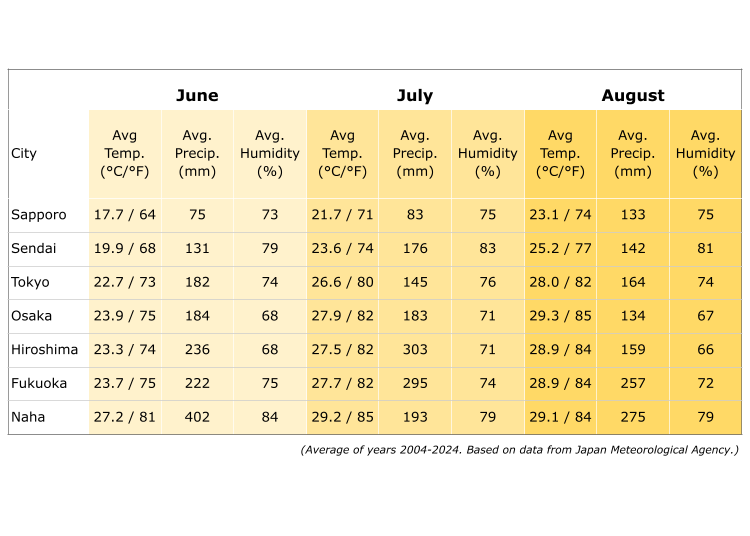
June
June signals the start of Japan’s tsuyu (rainy season) in most areas. Tokyo, Osaka, and Fukuoka experience warm temperatures and high humidity, along with frequent—but often brief—showers. Hokkaido, however, stays mostly dry and is an ideal escape this month. Light, breathable clothing and a compact umbrella are must-haves. Despite the rain, June is lush and green—great for garden lovers. Tokyo sunset times range from 6:50 PM to just after 7:00 PM, allowing for long, damp-but-beautiful evenings. Be aware of occasional heavy rain warnings (keiho) and have indoor alternatives ready.
- Outerwear
- Thin outerwear or a light rain jacket (especially in central/southern Japan)
- Tops
- Short-sleeved shirts; light blouses; breathable fabrics like cotton or linen
- Bottoms
- Thin pants, jeans, or a long skirt; dresses or one-pieces for airflow
- Footwear & Accessories
- Sneakers or sandals (water-friendly if possible); compact umbrella or rain poncho; sunscreen; antiperspirant; optional sun hat or portable fan
July

July is hot and humid in most of Japan, with the rainy season ending mid-month in many areas. UV levels are high, so sun protection—like a hat and sunscreen—is essential. Traditional summer festivals begin to pop up, and fireworks events fill the calendar. In the north, Sapporo enjoys more comfortable weather, drawing many Japanese travelers. Sunset in Tokyo starts at 7:00 PM early in the month and gradually shortens to around 6:45 PM. July is a great time to try Japanese kakigori (shaved ice) or summer-only foods like cold soba.
- Outerwear
- Thin, breathable layers or UV-protective rash guards; optional light jacket for sun or AC
- Tops
- Lightweight shirts or tops made of cotton or linen; UV-protective options ideal
- Bottoms
- Wide pants, airy long pants, shorts, or light skirts
- Footwear & Accessories
- Sneakers or sandals; sun hat or cap; handkerchiefs or small towel; wet tissues; sunscreen; antiperspirant
August

August is the peak of summer, and the heat can be intense in Tokyo, Osaka, and Fukuoka and other points south. Be cautious about heatstroke—hydration and sun protection are vital. Lightweight, breathable clothes are a must. In contrast, Sapporo remains relatively cooler and is a popular refuge. This month also features Obon, a traditional holiday where many people return to their hometowns; expect crowded trains and busy festivals around mid-month. Sunset in Tokyo shifts from around 6:45 PM to 6:10 PM. Evening fireworks offer a fun look into Japanese summer culture.
- Outerwear
- Thin, breathable cover-up or UV-protective jacket (for sun or strong air conditioning)
- Tops
- T-shirts, light shirts, or UV-protective wear made of cotton or linen
- Bottoms
- Wide-leg pants, airy long pants, shorts, or skirts
- Wide-leg pants, airy long pants, shorts, or skirts
- Sneakers or sandals; sun hat or cap; handkerchief or small towel; wet tissues; sunscreen; antiperspirant
Typhoon season
Japan experiences about 40 typhoons per year, with most forming between July and September. Okinawa and Kyushu are most frequently affected, but Tokyo and Osaka can also experience strong winds and heavy rain. If a typhoon is approaching, stay updated via local forecasts and avoid outdoor plans. Transportation—including trains and flights—may be delayed or canceled.
What to Wear in Japan in Autumn (September/October/November)

Autumn is one of the most stunning seasons in Japan. From late September through November, the landscapes turn brilliant shades of red, yellow, and gold. The weather becomes crisp and dry, offering perfect conditions for sightseeing, hiking, or exploring temples and gardens.
Temperatures vary widely, especially between day and night, so layering is once again your best strategy. Start the season in short sleeves and end it in sweaters and coats. Late November is peak foliage season in Tokyo and Kyoto—don’t miss the special evening light-ups at famous temples.

September
September begins hot and humid but gradually cools toward the end of the month. Typhoons are more common during this time, so check the weather forecast daily. Early September still feels like summer in Tokyo and Osaka, while Sapporo enjoys crisp, early autumn days. Sunset in Tokyo shortens from 6:05 PM to 5:25 PM, signaling the shift toward fall. September is also a great time to try seasonal foods like matsutake mushrooms or sanma (Pacific saury), which appear on menus across Japan.
- Outerwear
- Cardigan, light coat, or thin jacket (especially for Sapporo or cooler evenings)
- Tops
- Short-sleeved shirt; thin long-sleeved top; lightweight blouse or one-piece
- Bottoms
- Long skirt, jeans, or breathable pants
- Long skirt, jeans, or breathable pants
- Sneakers or flats; compact umbrella; handkerchief or towel; sunscreen (UV still strong early in the month)
October

October is a favorite month among locals and travelers alike. The weather is dry, cool, and ideal for sightseeing. Autumn foliage begins to appear in northern regions like Sapporo and gradually moves south. Tokyo and Osaka remain mild, but layering is helpful for cooler evenings. Sunset in Tokyo moves from 5:25 PM to 4:45 PM, so plan to finish outdoor activities earlier in the day. Many Japanese schools and neighborhoods hold autumn festivals this month—first-time visitors may stumble upon one in a local park or shrine.
- Outerwear
- Cardigan, windbreaker, or denim jacket; medium jacket for Sapporo
- Tops
- Long-sleeved shirts; thick dress or sweater-like tops
- Bottoms
- Jeans or full-length pants
- Footwear & Accessories
- Sneakers or flats; thin muffler or stole; compact umbrella
November

November is peak autumn foliage season across most of Japan. Cities like Tokyo and Osaka are full of color, and regional temples and parks light up for night viewings. While days are sunny and cool, mornings and evenings are quite chilly—especially in northern areas. Sunset in Tokyo arrives early, from around 4:45 PM to 4:30 PM, so get outside by midafternoon for the best leaf viewing. Japanese people often take seasonal cues seriously, and November menus begin to feature warming foods like oden and nabe (hot pot).
- Outerwear
- Windbreaker; thick cardigan; coat or medium jacket; down jacket (especially for Sapporo)
- Tops
- Long-sleeved shirts; sweaters; knitted tops or layered cardigans
- Bottoms
- Jeans or other full-length pants
- Footwear & Accessories
- Sneakers, boots, or flats; muffler or scarf; hat; gloves (especially for colder regions)
What to Wear in Japan in Winter (December/January/February)

Winter in Japan is dry and brisk, especially in central and eastern cities like Tokyo and Osaka. Snow is rare in those areas but common in the north—Hokkaido, the Japan Alps, and Tohoku are famous for their powdery snow and ski resorts.
Tokyo’s daylight is shortest in December, with sunset around 4:30 PM. By February, it extends to about 5:30 PM. Plan your day trips with this in mind.
Warm layers are essential, but keep in mind that most indoor spaces are well-heated—so a coat you can easily take off, plus a medium-size bag to carry it, will be helpful. Because of the dry air, consider packing lip balm, hand cream, and a refillable water bottle.
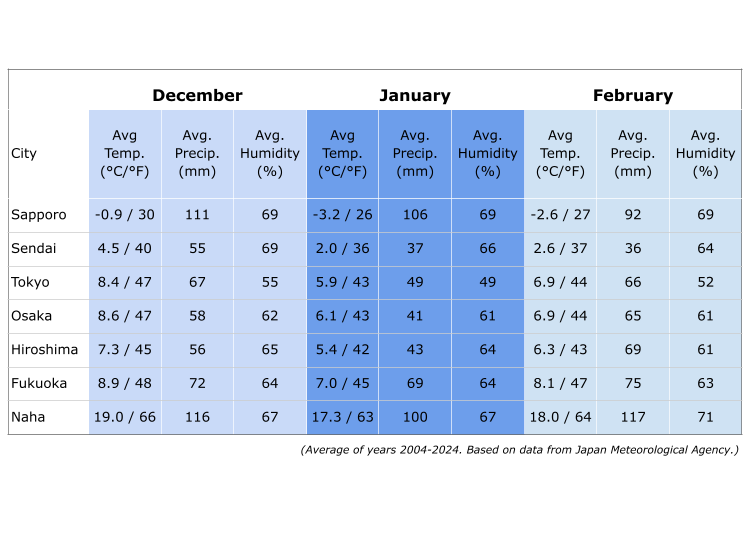
- Winter Sightseeing in Tokyo Done Right: What to Know and What to Bring
- Visiting Kyoto in Winter: Weather and Clothes You Need
- Visiting Osaka in Winter: Osaka Weather and Clothes You Need
- Visiting Hokkaido in Winter: Best Things to Do in Winter, Weather & What to Pack
- Visiting Sendai in Winter: Weather, Clothes, and Everything You Need to Know For Your Trip
December

December in Japan brings dry, sunny weather in much of the country, but real winter cold has set in—especially up north. Tokyo and Osaka remain brisk but manageable, while Sapporo is fully snow-covered. Illuminations and festive markets make evening walks especially magical. According to the traditional calendar, the toji (winter solstice) around December 21 is a time for yuzu baths and kabocha (pumpkin) dishes, both believed to ward off illness. Sunset in Tokyo is at its earliest—around 4:25 PM to 4:35 PM—so plan your outdoor activities accordingly and savor the winter lights after dark.
- Outerwear
- Wool coat or down jacket (heavy-duty outerwear needed for Sapporo); optional mid-layer like a fleece or thermal-lined hoodie
- Tops
- Warm undershirt or thermal base layer; thick sweater or knit top
- Bottoms
- Long pants; optional warm tights or thermal leggings for extra insulation
- Footwear & Accessories
- Sneakers or boots (snow boots for Sapporo); muffler or scarf; gloves; hat; optional warm socks or hand warmers
January

January is Japan’s coldest month of the year. Because of that, around January 20 marks the start of daikan (大寒), or the “coldest season,” according to the traditional calendar. The air is dry and crisp in Tokyo, Osaka, and Fukuoka, with frequent sunshine. Sapporo, however, is in full winter mode, with deep snow and icy roads. Warm layers are essential. Expect early sunsets—Tokyo’s daylight fades between 4:40 PM and 5:05 PM—so plan sightseeing accordingly. Winter illuminations are popular this month, especially in urban areas.
- Outerwear
- Wool coat or down jacket; layered option (e.g., thin down under coat) recommended; heavy coat or parka for Sapporo
- Tops
- Thermal undershirt or warm base layer; thick sweater, wool knit, or fleece
- Bottoms
- Long pants; optional warm tights or thermal leggings
- Footwear & Accessories
- Boots or sneakers (snow boots for Sapporo); scarf; hat; gloves; ear warmers; warm socks; face mask (for wind or dryness)
February

February remains chilly across Japan, especially in the mornings and evenings. It’s also prime snow season in northern areas like Sapporo, which hosts its famous Snow Festival during this month. Central and southern cities like Tokyo and Osaka stay dry and sunny. Pollen season begins late in the month, so visitors with allergies may want to pack masks or medication. Tokyo’s sunsets grow a little later, from around 5:10 PM to 5:35 PM—perfect for catching evening light at shrines or gardens.
- Outerwear
- Wool coat; thick jacket or down jacket; optional windbreaker for layering or dry days; heavy winter coat for Sapporo
- Tops
- Thermal base layer or warm undergarments; thick hoodie or sweater
- Bottoms
- Long pants; optional warm tights or thermal leggings for extra warmth
- Footwear & Accessories
- Sneakers or boots (snow boots for Sapporo); scarf; hat; gloves; ear warmers; warm socks; face mask (for wind, dryness, or pollen starting late in the month)
As you can now see, Japan experiences drastic changes in temperature and weather according to the season, making it all the more important to choose the right clothing for the time of year. But bringing a large amount of clothes to protect against the heat or cold can be burdensome when you want to leave extra room in your suitcase for souvenir shopping.
Check Out ‘Any Wear, Anywhere’ – Smart Packing Made Easy

Looking to lighten your luggage? ‘Any Wear, Anywhere’ is a clothing rental service in Japan that lets travelers rent stylish, seasonal outfits instead of packing their own. The clothes include surplus stock and secondhand items from Japanese households, making the service both convenient and eco-friendly. By renting, you reduce baggage weight and carbon emissions—perfect for mindful travel.
How It Works: Renting with Ease

Simply visit the official website, choose a style and season, and reserve your outfit.

Clothes will be delivered to your hotel and can be returned there after use—no need to worry about packing on your final day.

Sizes range from XS to 3XL (kids’ sizes 80–160) and options are available for men, women, and children. You can also choose from a combination of styles and season (spring/autumn, summer or winter).
What You Can Rent: Seasonal Clothing Examples
Travelers Romain and Michaela tried out some of the rental clothes in three different seasonal styles: spring/autumn, summer, and winter. They were very interested in the eco-friendly ‘Any Wear, Anywhere’ service and were keen to share their thoughts on using it.


Romain and Michaela first tried the spring/autumn outfits—ideal for Japan’s mild but unpredictable weather. “The jacket means I don’t have to worry about chilly days,” says Romain. Michaela adds, “It’s a relief not having to think about matching clothes while traveling.”

The summer line-up is perfect for Japan’s hot, humid weather. “Lightweight shirts and pants are ideal for staying cool,” says Romain. Michaela adds, “Sleeveless tops and knee-length skirts work well for everyone.”

Winter in Japan calls for warm layers, and ‘Any Wear, Anywhere’ offers functional rentals, including jackets. “I didn’t know you could rent a down coat—now I can pack lighter and travel with less stress,” says Romain. Michaela adds, “It’s a huge relief not having to carry a bulky coat on the plane.” Both were thrilled to wear stylish, recycled clothing while traveling more sustainably.
(*Note: Accessories not included.)
‘Any Wear, Anywhere’ lets you rent stylish, seasonal clothing in Japan—making travel lighter and more eco-friendly. Available in various sizes and styles, it’s a smart, sustainable way to pack less.
Helpful Articles for Planning Your Japan trip
The LIVE JAPAN editorial team is a multinational group made up of native editors who have lived in Japan for over five years and Japanese editors who love to travel. Together, we share the best of Japan, offering cultural insights, historical context, event updates, and travel-friendly deals, to support your journey every step of the way.
- Category
*Prices and options mentioned are subject to change.
*Unless stated otherwise, all prices include tax.
Popular Tours & Activitiess
Recommended places for you
-
Appealing

Rukku and Uohei
Izakaya
Sapporo / Chitose
-

Kanzenkoshitsuyakinikutabehodai Gyugyu Paradise Sannomiya
Yakiniku
Kobe, Sannomiya, Kitano
-
Goods
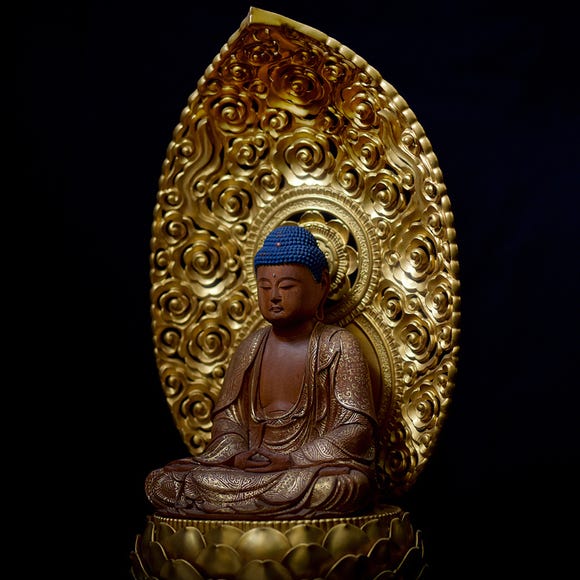
Yoshida Gennojo-Roho Kyoto Buddhist Altars
Gift Shops
Nijo Castle, Kyoto Imperial Palace
-

Kambei Sannomiyahonten
Yakiniku
Kobe, Sannomiya, Kitano
-

Jukuseiniku-to Namamottsuarera Nikubaru Italian Nikutaria Sannomiya
Izakaya
Kobe, Sannomiya, Kitano
-

ISHIDAYA Hanare
Yakiniku
Kobe, Sannomiya, Kitano
-

A Don Quijote Like No Other: Step Inside the All-New Tourist-Friendly Store at Shinjuku Tonanguchi Bekkan
by: Chehui Peh
-

Fine Dining on Rails? Japan Announces Stunning NEW 'Laview' Restaurant Train
-
Ad

Okinawa Travel Troubles? Guide to the MCC Hotline for Illness and Weather Emergencies
-
Ad

Just 2 Hours from Tokyo! Enjoy Ibaraki’s Breathtaking Ocean Views, Flowers & Autumn Leaves on Private Tours
-

(12% OFF KKday Coupon) Mt. Fuji Autumn Leaves, Powder Snow & More! 15 Best Tours to Experience Japan in Fall & Winter
-
Ad

Get Your Perfect Custom Suit at GINZA Global Style PREMIUM Ginza Honten: Choose from 5,000 Fabrics, Starting at 26,400 Yen (incl. tax)!
-
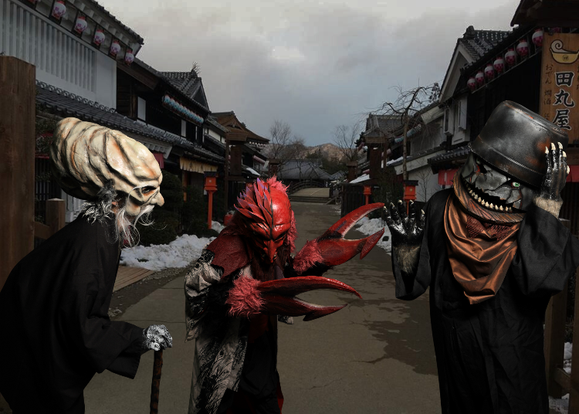
November Events in Tokyo: Fun Festivals, Food, and Things to Do
-

10 Best Places to See Autumn Leaves in Fukushima Prefecture & When to Enjoy in 2025
by: Guest Contributor
-

Visiting Hokkaido Japan: 14 Things to Know Before Traveling to Japan's Wild North
-

Visiting Tsutenkaku Tower: Osaka's Retro Icon in the Heart of Shinsekai
by: Guest Contributor
-

Michelin Star Restaurants & More: 3 Best Okonomiyaki Shops in Dotonbori Osaka
-

Sendai in Autumn: Weather Guide for September–November, Outfit Tips & Must-See Spots
by: Nemi Lin
- #best sushi japan
- #what to do in odaiba
- #what to bring to japan
- #new years in tokyo
- #best ramen japan
- #what to buy in ameyoko
- #japanese nail trends
- #things to do japan
- #onsen tattoo friendly tokyo
- #daiso
- #best coffee japan
- #best japanese soft drinks
- #best yakiniku japan
- #japanese fashion culture
- #japanese convenience store snacks






































